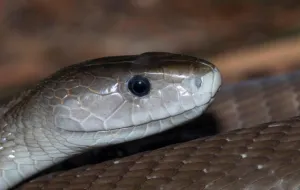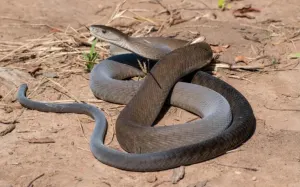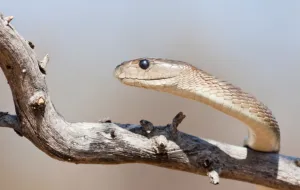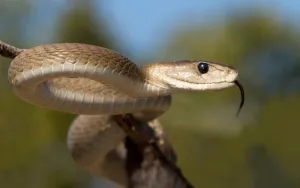
Table of Contents
Scientific Classification
- Kingdom: Animalia
- Phylum: Chordata
- Class: Reptilia
- Order: Squamata
- Suborder: Serpentes
- Family: Elapidae
- Genus: Dendroaspis
- Species: D. polylepis
Quick Overview
The Black Mamba (Dendroaspis polylepis) is a highly venomous and agile snake known for its striking appearance and potent neurotoxic venom. Found in the savannas and rocky hills of sub-Saharan Africa, the Black Mamba is one of the continent’s most feared and fastest snakes.
Fast Facts
- Scientific Name: Dendroaspis polylepis
- Lifespan: Up to 11 years in the wild; can exceed 20 years in captivity
- Average Length: 8 to 10 feet (can reach lengths of 14 feet)
- Diet: Carnivorous (primarily small mammals and birds)
- Habitat: Savannas, rocky hills, and open woodlands
Did you know?
Despite its name, the Black Mamba’s mouth is not black but rather dark gray or brown.
Appearance
The Black Mamba earns its name from the inky black coloration inside its mouth, displayed in defensive postures. Its body, however, is typically olive to brown, earning it the nickname “green mamba.” The Black Mamba’s slender and elongated body contributes to its impressive speed.
Size and Weight
Adult Black Mambas generally range from 8 to 10 feet, with some individuals reaching lengths of 14 feet. They are known for their slender build and rapid movements.
Temperament and Behavior
Black Mambas are highly alert and notoriously aggressive when threatened. They are exceptional climbers and may seek refuge in trees or bushes. Despite their reputation, they often prefer to flee rather than confront potential threats.
Habitat and Distribution
Found in sub-Saharan Africa, Black Mambas inhabit a range of environments, from savannas and rocky hills to open woodlands. They are adaptable and thrive in various ecosystems.

Care Guide
While not common in captivity due to their aggressive nature and specific care requirements, providing for a Black Mamba would involve:
- A secure and spacious enclosure with climbing opportunities.
- Temperature gradient between 77-86°F.
- Adequate hiding spots and elevated perches.
- A water source for drinking and soaking.
Diet and Nutrition
In the wild, Black Mambas prey on small mammals and birds. In captivity, a diet consisting of appropriately-sized rodents is suitable.
Health and Wellness
Due to their venomous nature, any bites from Black Mambas can be fatal. Handling should be avoided, and medical attention is crucial in the event of a bite. Regular veterinary consultation is necessary for captive specimens.
Breeding
Black Mambas lay clutches of eggs, with the incubation period lasting about two to three months. Hatchlings are independent upon emerging.
Conservation Status
While not currently classified as endangered, habitat loss and human-animal conflict pose threats to Black Mamba populations. Conservation efforts focus on preserving their natural habitats.
Photo Gallery




Related Profiles
Share This Profile
3 Fascinating Facts About Black Mamba
- Speed Demon: The Black Mamba is one of the fastest snakes, capable of reaching speeds up to 12 miles per hour.
- Venomous Arsenal: With potent neurotoxins, the Black Mamba’s venom is a formidable weapon, causing rapid paralysis in prey.
- Elevated Elegance: Known for its agility, the Black Mamba can raise a third of its body off the ground while in motion, showcasing its remarkable locomotion.
- Enchi Ball Python: A Unique and Stunning Morph of Python regius - March 27, 2025
- Emerald Tree Monitor: The Enigmatic Green Guardian of the Rainforest - March 26, 2025
- The Egyptian Cobra (Naja haje): A Fascinating Serpent - March 25, 2025
